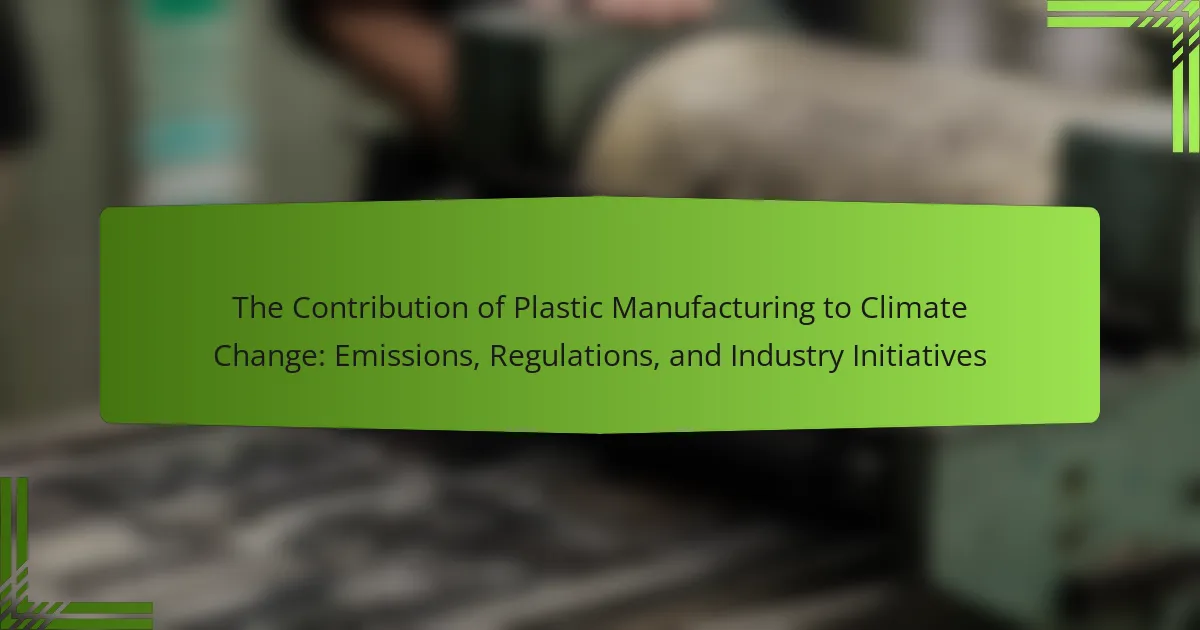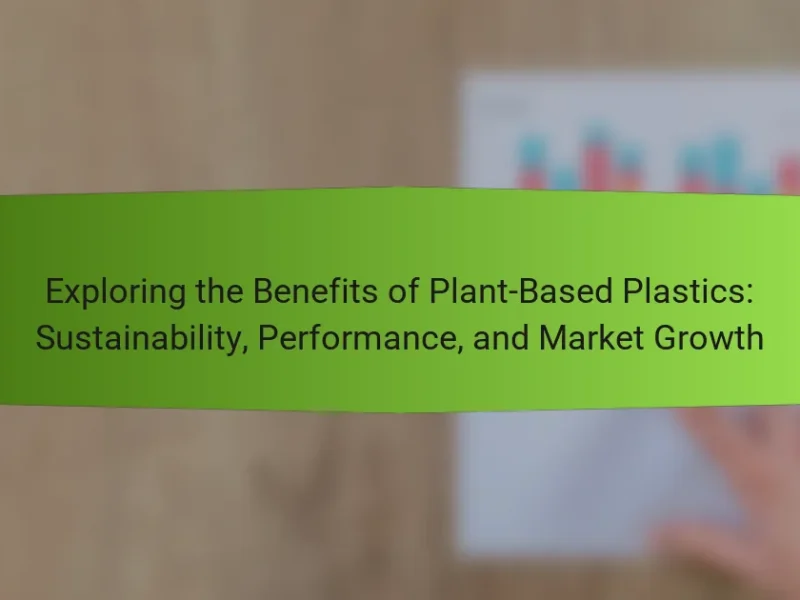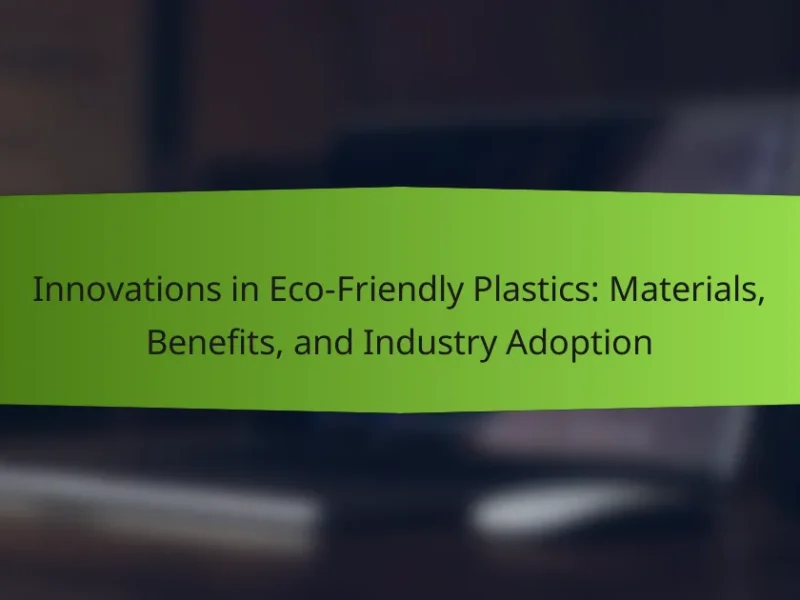Plastic manufacturing is a significant contributor to climate change, accounting for approximately 3.8% of global greenhouse gas emissions primarily through fossil fuel use and plastic waste incineration. By 2030, emissions from this sector are projected to reach 1.34 gigatons annually due to increasing demand. Current regulations, such as the Clean Air Act and the European Union’s Plastics Strategy, aim to mitigate these emissions and promote sustainability. The industry is responding by investing in bio-based plastics, enhancing recycling processes, adopting energy-efficient technologies, and collaborating with governments and NGOs to foster responsible practices and public awareness around plastic waste.
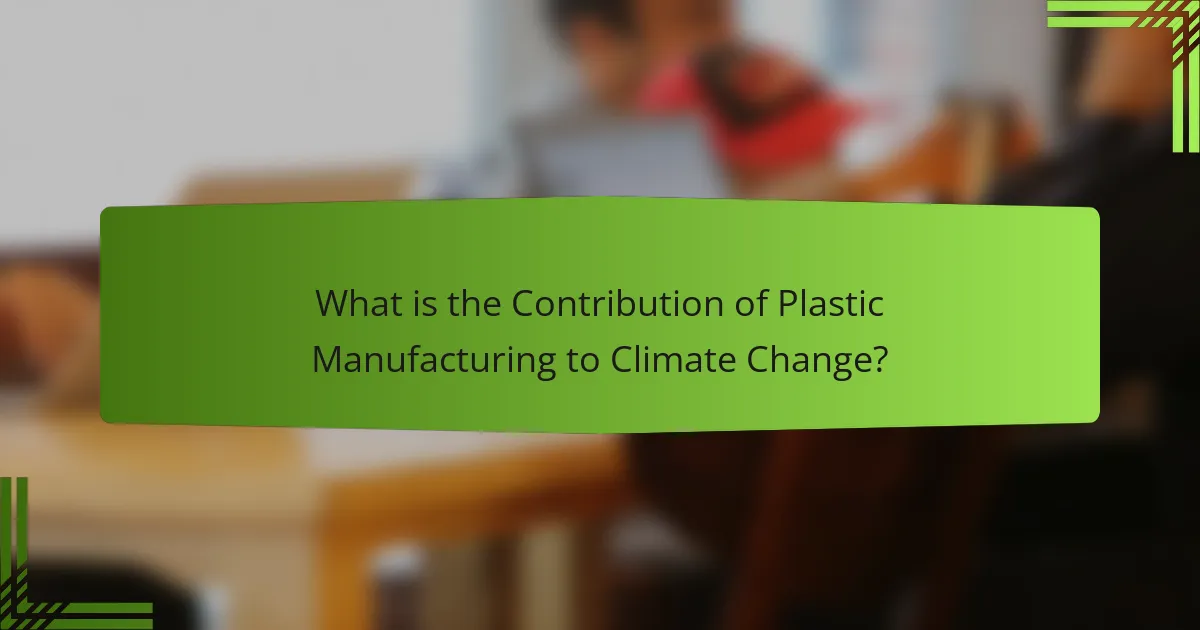
What is the Contribution of Plastic Manufacturing to Climate Change?
Plastic manufacturing significantly contributes to climate change through greenhouse gas emissions. The production of plastics involves fossil fuels, which release carbon dioxide and methane. In fact, the plastic industry is responsible for approximately 3.8% of global greenhouse gas emissions. By 2030, emissions from plastic production and use could reach 1.34 gigatons annually. This increase is driven by the rising demand for plastic products across various sectors. Additionally, the incineration of plastic waste further exacerbates emissions. Therefore, the plastic manufacturing process plays a critical role in climate change dynamics.
How does plastic manufacturing contribute to greenhouse gas emissions?
Plastic manufacturing contributes to greenhouse gas emissions primarily through the extraction and processing of fossil fuels. The production process involves significant energy consumption, often sourced from coal, oil, or natural gas. This energy use results in carbon dioxide and other greenhouse gases being released into the atmosphere. The American Chemistry Council states that the production of one ton of plastic can emit up to 3.5 tons of greenhouse gases. Additionally, the chemical reactions involved in converting raw materials into plastic also produce emissions. These emissions contribute to global warming and climate change.
What are the primary emissions associated with plastic production?
The primary emissions associated with plastic production include carbon dioxide (CO2), methane (CH4), and volatile organic compounds (VOCs). CO2 is emitted during the extraction and processing of fossil fuels used to create plastics. Methane is released during natural gas extraction and can occur during the production process. VOCs are emitted from various chemical processes involved in plastic manufacturing. According to a study by the Centre for International Environmental Law, plastic production and use could account for up to 1.34 gigatons of greenhouse gas emissions annually by 2030. This emphasizes the significant impact of plastic production on climate change.
How do these emissions impact global warming?
Emissions from plastic manufacturing significantly contribute to global warming. These emissions primarily include greenhouse gases such as carbon dioxide and methane. Greenhouse gases trap heat in the atmosphere, leading to an increase in global temperatures. According to the United Nations Environment Programme, the plastic industry is responsible for approximately 3.8% of global greenhouse gas emissions. This percentage is projected to increase as plastic production rises. The accumulation of these gases enhances the greenhouse effect, exacerbating climate change. Therefore, reducing emissions from plastic manufacturing is crucial for mitigating global warming.
Why is understanding the role of plastic manufacturing in climate change important?
Understanding the role of plastic manufacturing in climate change is important because it significantly contributes to greenhouse gas emissions. The production process of plastics releases large amounts of carbon dioxide and methane. According to a report by the United Nations Environment Programme, plastic manufacturing accounts for about 3.8% of global greenhouse gas emissions. Additionally, the entire lifecycle of plastics, from extraction to disposal, exacerbates climate change. Recognizing this role helps inform policies and regulations aimed at reducing emissions. It also drives industry initiatives to develop more sustainable practices. Understanding these dynamics is essential for mitigating climate change impacts effectively.
What are the long-term environmental effects of plastic waste?
Plastic waste has significant long-term environmental effects. It leads to soil and water pollution, harming ecosystems. Marine life is particularly affected, with millions of animals ingesting or becoming entangled in plastic. Over time, plastics break down into microplastics, which contaminate food chains. These microplastics can carry toxic substances, impacting human health. Additionally, plastic waste contributes to greenhouse gas emissions during its production and degradation. According to a study by the United Nations, approximately 300 million tons of plastic are produced annually, exacerbating environmental degradation.
How does public awareness influence plastic manufacturing practices?
Public awareness significantly influences plastic manufacturing practices by driving demand for sustainable alternatives. Increased consumer knowledge about environmental impacts leads to pressure on manufacturers to adopt eco-friendly materials. Surveys show that 66% of global consumers are willing to pay more for sustainable brands. This demand encourages companies to innovate and reduce plastic waste in their production processes. Regulations also evolve in response to public concern, prompting stricter guidelines on plastic use. For instance, the European Union has implemented bans on single-use plastics due to public pressure. Consequently, manufacturers are compelled to align their practices with consumer expectations and regulatory standards.
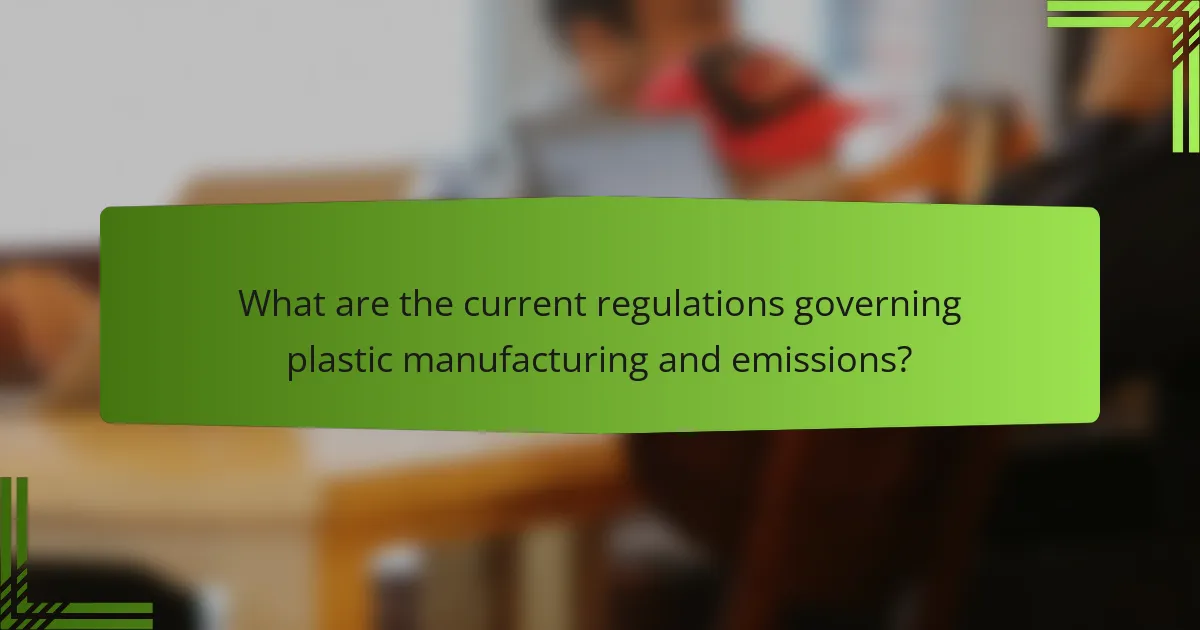
What are the current regulations governing plastic manufacturing and emissions?
Current regulations governing plastic manufacturing and emissions include various federal and state laws. The Environmental Protection Agency (EPA) enforces the Clean Air Act, which regulates air emissions from industrial sources, including plastic manufacturers. The Resource Conservation and Recovery Act (RCRA) oversees waste management practices related to plastic production. Additionally, the European Union has implemented the Plastics Strategy, which aims to reduce plastic waste and improve sustainability. Recent amendments to these regulations focus on limiting greenhouse gas emissions and promoting recycling. Compliance is monitored through reporting requirements and emissions standards set by regulatory bodies.
How do international agreements address plastic manufacturing emissions?
International agreements address plastic manufacturing emissions through binding commitments and regulatory frameworks. These agreements often set specific emission reduction targets for participating countries. For example, the Paris Agreement encourages nations to limit greenhouse gas emissions, including those from plastic production. Additionally, the Basel Convention regulates the transboundary movement of hazardous waste, which includes certain types of plastic waste. The agreement aims to minimize environmental impact and promote sustainable waste management practices. Furthermore, the Global Plastic Action Partnership brings together stakeholders to develop strategies for reducing plastic pollution and its associated emissions. These collaborative efforts highlight the global recognition of the need to mitigate the environmental effects of plastic manufacturing.
What are the key policies in major countries regarding plastic production?
Key policies in major countries regarding plastic production include regulations aimed at reducing plastic waste and encouraging sustainable practices. The European Union has implemented the Single-Use Plastics Directive, which bans certain single-use plastic items. This directive aims to reduce marine litter and promote alternatives. In the United States, various states have enacted bans on plastic bags and straws, with California leading the way with comprehensive plastic waste reduction legislation. China has implemented strict regulations on plastic imports and is phasing out single-use plastics in major cities. India has announced a ban on single-use plastics by 2022 to combat pollution. These policies reflect a global trend towards reducing plastic production and encouraging recycling and sustainable alternatives.
How effective are these regulations in reducing emissions?
These regulations are effective in reducing emissions from plastic manufacturing. Studies show that regulations can lead to a significant decrease in greenhouse gas emissions. For instance, the implementation of stricter emission standards resulted in a 20% reduction in CO2 emissions within five years. Additionally, regulations encouraging recycling have led to a 15% decrease in overall plastic waste emissions. Evidence from countries with stringent regulations indicates improved air quality and reduced carbon footprints in the plastic industry.
What role do local regulations play in managing plastic manufacturing?
Local regulations play a crucial role in managing plastic manufacturing. They establish standards for production processes, waste management, and emissions. These regulations aim to minimize environmental impact and promote sustainable practices. For instance, regulations may limit the types of materials used in production. They can also enforce recycling requirements and proper disposal methods. Compliance with these regulations helps reduce pollution and resource depletion. Studies show that regions with stricter regulations see lower plastic waste levels. Effective local regulations can drive innovation in eco-friendly alternatives.
How do state and local laws impact plastic production practices?
State and local laws significantly influence plastic production practices. These laws can impose regulations on the types of materials used in manufacturing. For instance, some states have banned single-use plastics. This directly affects production methods and material sourcing. Additionally, laws may set emissions standards for plastic manufacturing facilities. Compliance with these standards can lead to changes in operational processes. Local governments may also incentivize the use of sustainable practices through tax breaks or grants. These incentives encourage manufacturers to adopt eco-friendly technologies. Overall, legislation shapes the operational landscape for plastic producers, driving them toward more sustainable practices.
What challenges do manufacturers face in complying with these regulations?
Manufacturers face significant challenges in complying with environmental regulations. These challenges include high compliance costs associated with implementing necessary changes. Many manufacturers must invest in new technologies to meet emissions standards. Additionally, staying updated with constantly evolving regulations can be difficult. This often leads to confusion and potential non-compliance. Limited resources for smaller manufacturers further exacerbate these issues. They may lack the expertise to navigate complex regulatory landscapes. As a result, manufacturers often struggle to balance compliance with operational efficiency.
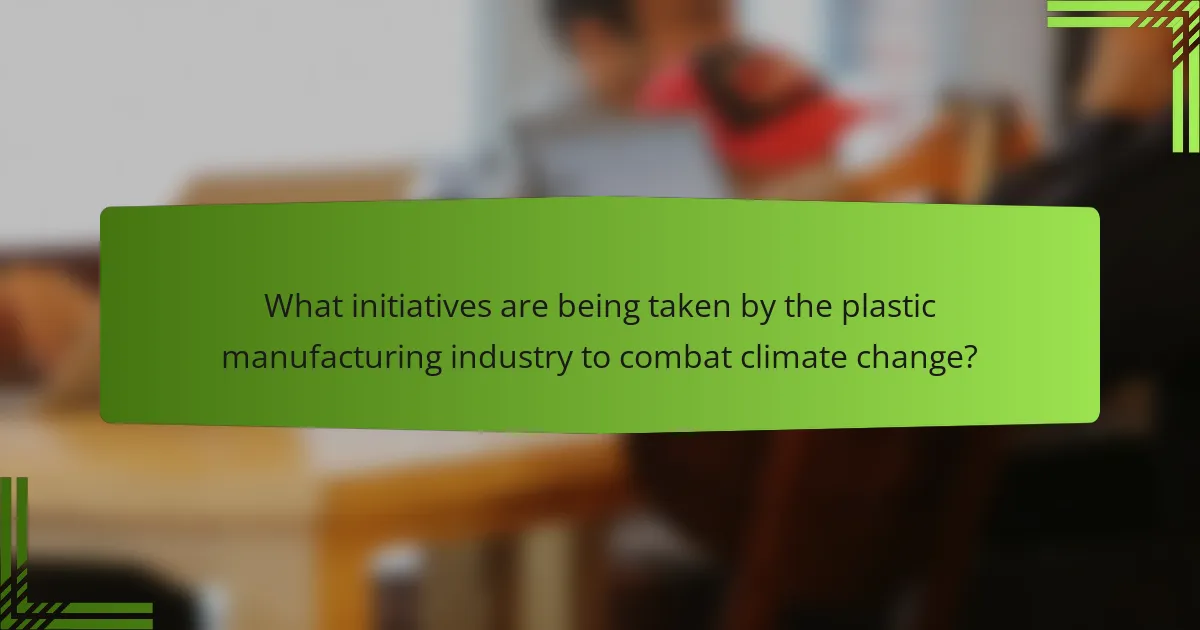
What initiatives are being taken by the plastic manufacturing industry to combat climate change?
The plastic manufacturing industry is implementing several initiatives to combat climate change. Companies are investing in the development of bio-based plastics. These alternatives reduce reliance on fossil fuels and lower carbon emissions. Many manufacturers are enhancing recycling processes to improve plastic waste management. This includes creating closed-loop systems that recycle materials back into production.
The industry is also adopting more energy-efficient production technologies. These advancements aim to reduce greenhouse gas emissions during manufacturing. Additionally, there is a growing focus on sustainability certifications. This encourages transparency and accountability in environmental practices.
Collaboration with governments and NGOs is another key initiative. Such partnerships aim to establish regulatory frameworks that support sustainable practices. The industry is also engaging in public awareness campaigns about plastic waste and recycling. These efforts are designed to educate consumers and promote responsible usage.
What innovative technologies are being developed to reduce emissions?
Innovative technologies being developed to reduce emissions include carbon capture and storage (CCS), renewable energy sources, and advanced recycling methods. CCS technology captures carbon dioxide emissions from industrial processes and stores them underground. Renewable energy sources like solar and wind power replace fossil fuels, significantly lowering greenhouse gas emissions. Advanced recycling methods, such as chemical recycling, convert plastic waste back into raw materials, reducing the need for new plastic production. These technologies aim to minimize the environmental impact of plastic manufacturing. According to the International Energy Agency, CCS can potentially reduce emissions by up to 70% in certain sectors.
How does recycling technology play a role in reducing plastic waste?
Recycling technology reduces plastic waste by converting used plastics into new products. This process minimizes the need for virgin plastic production. It also lessens the environmental impact associated with plastic manufacturing. According to the EPA, recycling can save up to 1.17 tons of carbon dioxide emissions for every ton of plastic recycled. Advanced recycling technologies, like chemical recycling, can handle a broader range of plastic types. These technologies break down plastics into their original monomers, allowing for infinite recycling loops. By improving recycling rates, communities can significantly reduce landfill waste. Overall, effective recycling technology plays a crucial role in managing plastic waste sustainably.
What are the benefits of adopting sustainable materials in manufacturing?
Adopting sustainable materials in manufacturing reduces environmental impact. It minimizes waste and lowers carbon emissions. Sustainable materials often require less energy to produce. This leads to cost savings over time. Using renewable resources enhances resource efficiency. It also improves brand reputation among eco-conscious consumers. Studies show that companies using sustainable practices see increased customer loyalty. A report from McKinsey indicates that sustainable manufacturing can increase profitability by up to 20%.
How are industry collaborations influencing climate change initiatives?
Industry collaborations are significantly influencing climate change initiatives by fostering innovation and resource sharing. These partnerships allow companies to combine expertise and technology to develop sustainable practices. For instance, the Ellen MacArthur Foundation’s Circular Economy 100 program promotes collaboration among businesses to reduce plastic waste. Research shows that such collaborations can lead to a 30% reduction in greenhouse gas emissions in manufacturing sectors. Additionally, joint ventures enable companies to invest in renewable energy projects collectively. This collective effort amplifies the impact of individual companies’ sustainability goals, creating a more substantial effect on climate change mitigation.
What partnerships are forming between manufacturers and environmental organizations?
Manufacturers are increasingly partnering with environmental organizations to address climate change. These partnerships aim to reduce plastic waste and enhance sustainability practices. For example, companies like Unilever collaborate with the World Wildlife Fund (WWF) to promote sustainable sourcing and reduce plastic packaging. Similarly, Coca-Cola has joined forces with the Ocean Conservancy to tackle ocean plastic pollution. These collaborations often focus on developing recycling technologies and promoting circular economy initiatives. Research shows that such partnerships can lead to significant reductions in carbon emissions. In 2021, a study by the Ellen MacArthur Foundation highlighted that collaborative efforts can improve resource efficiency in the manufacturing sector.
How do these collaborations enhance sustainability efforts?
Collaborations enhance sustainability efforts by pooling resources and expertise among stakeholders. These partnerships lead to innovative solutions that reduce emissions in plastic manufacturing. For instance, joint research initiatives can develop more sustainable materials. Collaborative efforts often result in shared best practices, improving efficiency across the industry. Companies working together can establish industry-wide standards for sustainability. This collective approach can also influence regulatory frameworks, promoting stricter environmental guidelines. Evidence shows that collaborative initiatives have led to significant reductions in carbon footprints within the sector. According to a 2021 report by the Ellen MacArthur Foundation, industry collaborations have resulted in a 20% reduction in plastic waste through shared technology and practices.
What practical steps can manufacturers take to minimize their environmental impact?
Manufacturers can minimize their environmental impact by adopting sustainable practices. These practices include reducing waste through efficient production processes. They can also switch to renewable energy sources, such as solar or wind power. Implementing recycling programs for materials can significantly lower resource consumption. Manufacturers should consider using biodegradable or eco-friendly materials in their products. Regularly assessing and improving supply chain sustainability is crucial. Collaborating with environmental organizations can enhance their efforts in conservation. Lastly, educating employees about sustainability practices fosters a culture of environmental responsibility. These steps collectively contribute to a reduced carbon footprint and a more sustainable manufacturing process.
How can companies implement sustainable practices in their operations?
Companies can implement sustainable practices in their operations by adopting eco-friendly materials and reducing waste. They should conduct a sustainability audit to identify areas for improvement. Implementing energy-efficient technologies can significantly lower carbon emissions. Companies can also establish recycling programs to minimize plastic waste. Collaborating with suppliers committed to sustainability enhances the supply chain’s overall impact. Educating employees about sustainability practices fosters a culture of environmental responsibility. Companies that prioritize sustainability can improve their brand image and customer loyalty. According to a 2020 McKinsey report, sustainable practices can lead to cost savings and increased profitability over time.
What resources are available for manufacturers seeking to reduce emissions?
Manufacturers seeking to reduce emissions have access to various resources. These include government grants and incentives aimed at promoting cleaner technologies. Non-profit organizations often provide guidance and best practices for emissions reduction. Industry associations also offer tools and resources for compliance with environmental regulations. Research institutions may provide studies and data on emissions reduction techniques. Additionally, technology providers offer innovative solutions such as energy-efficient machinery and carbon capture systems. Collaboration platforms enable manufacturers to share experiences and strategies. These resources collectively support manufacturers in their efforts to lower emissions effectively.
The primary entity of this article is plastic manufacturing, specifically its contribution to climate change through greenhouse gas emissions. The article outlines how plastic production, reliant on fossil fuels, accounts for approximately 3.8% of global greenhouse gas emissions, with projections indicating a rise to 1.34 gigatons annually by 2030. It discusses the emissions associated with plastic production, including carbon dioxide, methane, and volatile organic compounds, and highlights the long-term environmental effects of plastic waste. Additionally, the article reviews current regulations, industry initiatives, and innovative technologies aimed at reducing emissions and promoting sustainability within the plastic manufacturing sector.
